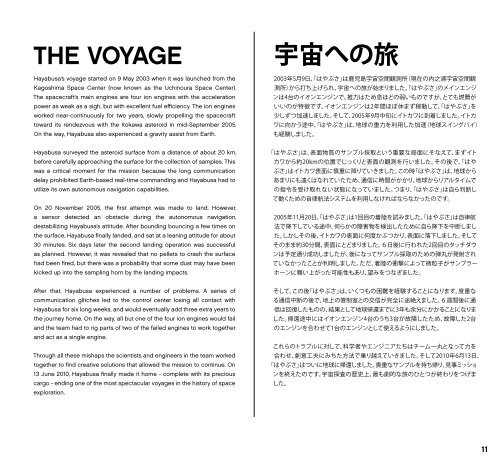Lego Hayabusa - 21101 (2012) - Shinkai 6500 BI 3005/88+4-115+150g GLUED 21101 V46
Lego Hayabusa - 21101 (2012) - Shinkai 6500 BI 3005/88+4-115+150g GLUED 21101 V46
Lego Hayabusa - 21101 (2012) - Shinkai 6500 BI 3005/88+4-115+150g GLUED 21101 V46
You also want an ePaper? Increase the reach of your titles
YUMPU automatically turns print PDFs into web optimized ePapers that Google loves.
the VOYAGe<br />
<strong>Hayabusa</strong>’s voyage started on 9 May 2003 when it was launched from the<br />
Kagoshima Space Center (now known as the Uchinoura Space Center).<br />
The spacecraft’s main engines are four ion engines with the acceleration<br />
power as weak as a sigh, but with excellent fuel efficiency. The ion engines<br />
worked near-continuously for two years, slowly propelling the spacecraft<br />
toward its rendezvous with the Itokawa asteroid in mid-September 2005.<br />
On the way, <strong>Hayabusa</strong> also experienced a gravity assist from Earth.<br />
<strong>Hayabusa</strong> surveyed the asteroid surface from a distance of about 20 km,<br />
before carefully approaching the surface for the collection of samples. This<br />
was a critical moment for the mission because the long communication<br />
delay prohibited Earth-based real-time commanding and <strong>Hayabusa</strong> had to<br />
utilize its own autonomous navigation capabilities.<br />
On 20 November 2005, the first attempt was made to land. However,<br />
a sensor detected an obstacle during the autonomous navigation,<br />
destabilizing <strong>Hayabusa</strong>’s attitude. After bounding bouncing a few times on<br />
the surface, <strong>Hayabusa</strong> finally landed, and sat at a leaning attitude for about<br />
30 minutes. Six days later the second landing operation was successful<br />
as planned. However, it was revealed that no pellets to crash the surface<br />
had been fired, but there was a probability that some dust may have been<br />
kicked up into the sampling horn by the landing impacts.<br />
After that, <strong>Hayabusa</strong> experienced a number of problems. A series of<br />
communication glitches led to the control center losing all contact with<br />
<strong>Hayabusa</strong> for six long weeks, and would eventually add three extra years to<br />
the journey home. On the way, all but one of the four ion engines would fail<br />
and the team had to rig parts of two of the failed engines to work together<br />
and act as a single engine.<br />
Through all these mishaps the scientists and engineers in the team worked<br />
together to find creative solutions that allowed the mission to continue. On<br />
13 June 2010, <strong>Hayabusa</strong> finally made it home - complete with its precious<br />
cargo - ending one of the most spectacular voyages in the history of space<br />
exploration.<br />
11
















